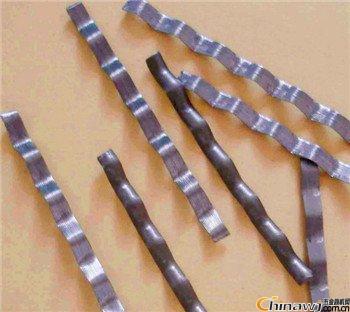The method used for cutting wires has a significant impact on the quality of concrete. To better suit its application, we will now introduce you to the cutting specifications and techniques involved in this process.
Wire cutting methods typically use cold-drawn steel wire with a small diameter ranging from 0.4 to 0.8 mm as the raw material. This wire is then cut into short steel fibers of a specific length. Common cutting methods include using a cutter, a punch, or a rotary cutter. These techniques help shape the steel fibers that are later added to concrete mixtures to improve their structural properties.
The tensile strength of steel fibers produced through this method is significantly higher than those made by other processes, often reaching up to 1000-2000 MPa. However, there are some drawbacks. Cold-drawn steel wire is costly, which makes the resulting steel fibers more expensive. Additionally, the surface of these fibers tends to be smooth, leading to weaker bonding with the surrounding concrete matrix.
To address these issues, new cutting techniques have been developed. These innovations aim to enhance the performance and cost-effectiveness of steel fibers.
1. **Waveform Method**: Before cutting, the steel wire is pressed into a wave-like shape using a pinch roller. This increases the surface area and improves bonding with concrete.
2. **Pressure-Increasing Method**: A prismatic pit is pressed onto the wire using the pinch roller, creating a textured surface that enhances adhesion.
3. **Hook Method**: The wire is shaped into a hook-like form before being cut, which also improves its mechanical interlock with the concrete.
These advanced methods are helping to overcome the limitations of traditional cutting techniques, making steel fiber-reinforced concrete more durable and efficient.
For more information on steel fiber cutting methods, visit [http://news.chinawj.com.cn](http://news.chinawj.com.cn)

Editor: (Hardware Business Network Information Center)
[http://news.chinawj.com.cn](http://news.chinawj.com.cn)

Hydraulic Quick Coupler
A hydraulic quick coupler is a device used to quickly and easily connect and disconnect hydraulic hoses and attachments. It is commonly used in construction, agriculture, and other industries where hydraulic systems are used.
The quick coupler typically consists of two main components: a male coupling and a female coupling. The male coupling is attached to the Hydraulic Hose or attachment, while the female coupling is attached to the hydraulic system.
To connect the hydraulic hose or attachment, the male coupling is inserted into the female coupling and securely locked into place. This can be done by sliding or twisting the couplings together, depending on the specific design.
The quick coupler allows for a fast and efficient connection and disconnection of hydraulic hoses and attachments, saving time and effort. It also provides a secure and leak-free connection, ensuring the hydraulic system operates properly.
There are different types of hydraulic quick couplers available, including flat face couplers, poppet couplers, and ball couplers. Each type has its own advantages and is suitable for different applications.
Overall, a hydraulic quick coupler is an essential tool for anyone working with hydraulic systems, as it provides a convenient and reliable way to connect and disconnect hydraulic hoses and attachments.
Hydraulic Quick Coupler; Quick Coupler; Hydraulic accessory; Hydraulic coupler; Hydraulic spare part
Yantai Dongyue Hydraulic Technology Co., Ltd , https://www.deeleap.com
 Editor: (Hardware Business Network Information Center)
[http://news.chinawj.com.cn](http://news.chinawj.com.cn)
Editor: (Hardware Business Network Information Center)
[http://news.chinawj.com.cn](http://news.chinawj.com.cn)

